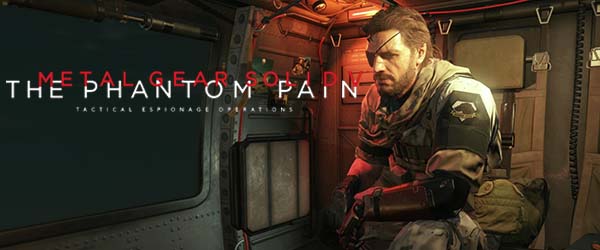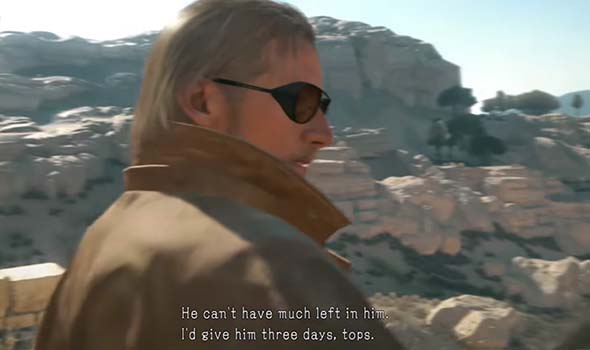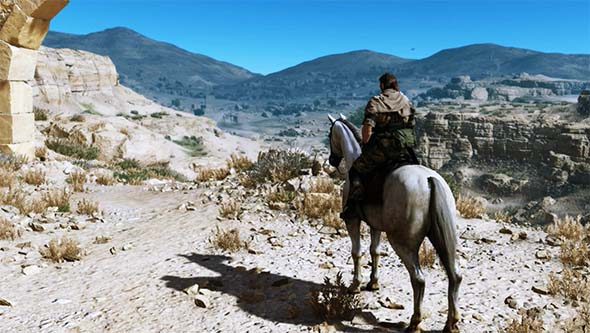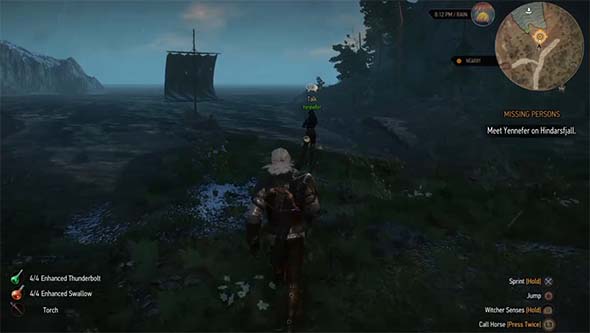
Are you one of the poor suckers who paid $30-40 for Ground Zeroes and were ready for The Phantom Pain to make up for your disappointment with what was little more than a glorified (and over-priced) demo? I wasn't, because I got Ground Zeroes for free from my PSPlus subscription around the same time that Phantom Pain was released. I was obviously disappointed with the demo's short length, and I didn't bother doing any of the side missions. But since I didn't pay for it, I wasn't as enraged as some other players might have been.
I actually really liked what little gameplay Ground Zeroes had to offer. The Guantanamo Bay arena was well-designed and offered some good infiltration challenge that tested my Metal Gear capabilities. The A.I. was surprisingly competent and adaptive - not so much that I couldn't exploit them occasionally, but still good. The graphics, lighting, and weather effects all looked outstanding. It was a fun experience. Not "forty dollars fun", but pretty fun. At least part of the battle at Mother Base should have been playable, and I didn't like that large elements of the story were hidden away in collectible audio tapes, but whatever.
I got Ground Zeroes for free on PSPlus, instead of paying $30-40 MSRP for a glorified demo.
Ground Zeroes gave me flashbacks to the phenomenal classic Sons of Liberty demo that came packaged with Zone of the Enders on the PS2. At least that only cost me a $3 rental, and I got to play Zone of the Enders too. After Ground Zeroes, I was looking forward to getting my hands on the much bigger Phantom Pain, and was optimistic that it would provide an equally good experience that would be worth the purchase price. Phantom Pain is a very long, very complicated, and very uneven game. So buckle up, friend. This is going to be a long review.
Table of Contents
After having written a lengthy blog post about how open world, sandbox game design almost necessarily puts the game's narrative in a state of limbo, I was amazed to start up Metal Gear Solid V and see the very first mission took my criticisms to heart. Of course, the game had already been released by the time I had written that opinion piece, so I can't take credit for having influenced its development, but it was still refreshing and gratifying. Anyway, in the very first mission, Ocelot tells you that Miller has been captured by Soviets in Afghanistan, has been tortured for intel, and has three days - tops - to live. You must rescue him before that time.

Ocelot gives the player three days to rescue Miller...
At first, I didn't put much stock in Ocelot's claim. After all, sandbox games are notorious for saying that something needs to be done ASAP, but they never have the balls to actually walk the walk and enforce that objective. Until now. When checking my map, I noticed something in the corner that I hadn't noticed in other sandbox games before: an "elapsed time" counter. The game was plainly tracking how long it was taking me to complete the primary mission objective. I treated this timer with a certain degree of skepticism. But sure enough, failure to rescue Miller within the allotted time actually results in a "Game Over"!
This is exactly how I feel that priority objectives in open world games should be handled: make it apparent to the player (through dialogue and/or explicit notification) that an objective is being timed or that it is otherwise a priority, and make sure that there are reasonable, perceivable consequences for failure to achieve that objective within the expected conditions. Then design some early-game quests or objectives such that the player is put in a position in which they can (or must) fail; thus, teaching the player that when the game says "do x or else", the game actually means it. I put down the controller and gave Hideo Kojima a standing ovation. But would this opening mission set a precedent that priority missions must actually be prioritized, and would that precedent stand throughout the rest of the game? Or was this just a one-off occurrence that would not be representative of the rest of the game? Regardless, a tone was plainly set for the rest of the game, and the stakes had been raised.
... Failure to rescue Miller within the allotted time results in his death and a Game Over.
Would this refreshing precedent carry over into the rest of the game? Well, sort of... [More]
11c3f412-b61e-422f-96c9-742ddb50d6fb|5|4.2
Tags:Metal Gear, Metal Gear Solid, Metal Gear Solid V: the Phantom Pain, Konami, Hideo Kojima, Fox Engine, tactical espionage operations, tactical espionage action, espionage, stealth, snake, Big Boss, Revolver Ocelot, Quiet, dog, Diamond Dogs, Afghanistan, Africa, open world, desert, sandbox, Fulton Recovery System, balloon, horse, Mother Base, helicopter, Soviet Union, Skull Face, Cipher, Zero, Sahelanthropus, Keifer Sutherland, David Hayter, ludonarrative, ludonarrative harmony, FOB, online, PvP, Metal Gear Online
Playing games like Skyrim, Grand Theft Auto, Assassin's Creed: Black Flag, The Witcher 3, Mad Max, Metal Gear Solid V, and other open-world games has made me increasingly weary of open-world gaming. Narrative-based, open world games like these suffer from a problem that I have started calling "open world limbo" (or "open world purgatory"). This is a sort of paradoxical offshoot of the concept of ludonarrative dissonance. The game's open world "sandbox" design seems to directly conflict with the narrative that the game is trying to tell. It specifically refers to the conflict between the story and the game's open world, rather than a conflict between the game's story and any particular game system(s). Generally, this manifests as the game designers setting the stakes so high that the player should feel pressured to progress the narrative, but the game's open world design never follows through with any real consequences for not progressing.

More and more big-budget games are going open world. is this a good thing?
This leads to problems in which the player can spend hours, weeks, or months doing tangential, or completely unrelated, tasks and pushing the game's story objectives down to the bottom of their priority list. For people who just like to play the game, this may not be much of a problem. They get a massive sandbox in which to do anything they want. That is actually one of the back-of-the-box selling point for most of these games.
But as one of those "games as art" kind of snobs, I also really like to have an engaging narrative that flows seamlessly with the gameplay. So if a game offers a narrative of any kind, you bet I'm going to judge the game based (at least in part) by how well that narrative works and how fully it is integrated into the core gameplay experience. And when a game tries to convince the player that they are destined to save the world from impending doom (as is often the case with big-budget, open world games), then I get really peeved when I find myself able to completely eschew that destiny in favor of picking flowers and peddling salvaged bandit armor for the next 100 hours.
A world in stasis
The source of most of the "limbo" comes down to the fact that these games' worlds (despite being big and detailed) often feel static and devoid of life. They don't change on their own. No one seems to have any sense of agency, and nothing ever happens unless the player is there to make it happen. Quest-givers sit around outside their house forever waiting for the player to come along and help them kill the wolves that are attacking their livestock, or find their missing heirloom, or deliver their special package to someone in the next town over, or whatever else they want done. The situation never resolves itself, the quest-giver never gets tired of waiting for you and hires another adventurer, those wolves never manage to eat all the remaining livestock, the heirloom never shows up in lost-and-found, and the statute of limitations on that package never expires. Emergencies can always wait [indefinitely] for the player to resolve them.

Quest-givers will wait forever for the player character to show up and solve their problems.
But worst of all is that the big, bad villain (if there is one) just doesn't feel very threatening or intimidating if he (or she, or it) isn't actually doing anything to actively antagonize the player or the world... [More]
ced5d1e2-3408-4ea8-8245-ca32f7affbe1|4|4.8
Tags:open world, limbo, option paralysis, narrative, ludonarrative, ludonarrative dissonance, consequences, punctuated equilibrium, quest, The Elder Scrolls, Oblivion, Skyrim, The Witcher 3, Grand Theft Auto, Final Fantasy, Mass Effect, The Legend of Zelda, Majora's Mask, Shadow of Mordor, Fallout, Sid Meier's Civilization, Cities: Skylines

Are you as sick of zombies as I am? They're everywhere. Perhaps the real zombie apocalypse won't be caused by radiation or a genetically-engineered plague; it will be caused by media corporations drowning our brains in zombie entertainment until we all go crazy and start eating each other.
Table of Contents
Fungus zombies
OK, sure, the creatures in Naughty Dog's latest adventure game, The Last of Us, aren't actually "zombies", they are humans infected with a fictionalized variation of Ophiocordyceps Unilateralis. But they're functionally the same thing. The "infected", as they are known as in the game, are mindless, mutated monsters that shamble around and eat any human they become aware of. And if they bite you, you become infected and the fungus takes over your brain, turns your flesh into spore-producing tendrils, and makes you a cannibal.
[LEFT] An ant infected with cordyceps.
[CENTER] A moth infected with cordyceps.
[RIGHT] A human infected with cordyceps, as depicted in The Last of Us.
The game takes place 20 years after the sudden outbreak of the human cordyceps infection that leads to the death of the protagonist's daughter. Society has collapsed into ruin, with the surviving 40% of people (including the protagonist, Joel) concentrated in quarantined ghettos in the remains of major cities. Joel is working as a smuggler, bringing food, weapons, and supplies into the Boston quarantine zone to be sold on the black market, and he is tasked with escorting a young girl, named Ellie, to a research lab out west. Ellie is unique in that she seems to be immune to the cordyceps infection. She was bitten weeks ago, and has suffered nothing more than some ugly skin lesions near the bite; whereas, everyone else begins to turn into a zombie within hours of being infected. This, of course, makes her survival paramount, and Joel must do whatever it takes to ensure her safe arrival at the lab so that the researchers can hopefully study her to find a cure or vaccine. [More]
b37fff55-ed98-484c-be2f-cd521976fb05|5|5.0
Tags:The Last of Us, Naughty Dog, Sony, PlayStation 3, PS3, review, action, adventure, platformer, survival, horror, survival horror, Joel, Ellie, cordyceps, fungus, cordie, zombie, ethics, morality, Hippocratic Oath, ludonarrative, Uncharted, Silent Hill 2, Resident Evil 4
|

| 12 | | | | | | | 60 | | 11 | | | | | | | 55 | | 10 | | | | | | | 50 | | 09 | | | | | | | 45 | | 08 | | | | | | | 40 | | 07 | | | | | | | 35 | | 06 | | | | | | | 30 | | 05 | | | | | | | 25 | | 04 | | | | | | | 20 | | 03 | | | | | | | 15 | | 02 | | | | | | | 10 | | 01 | | | | | | | 05 |
|